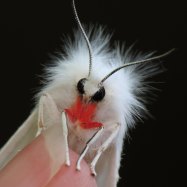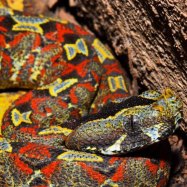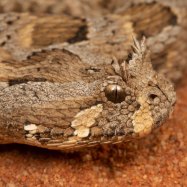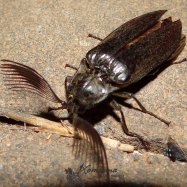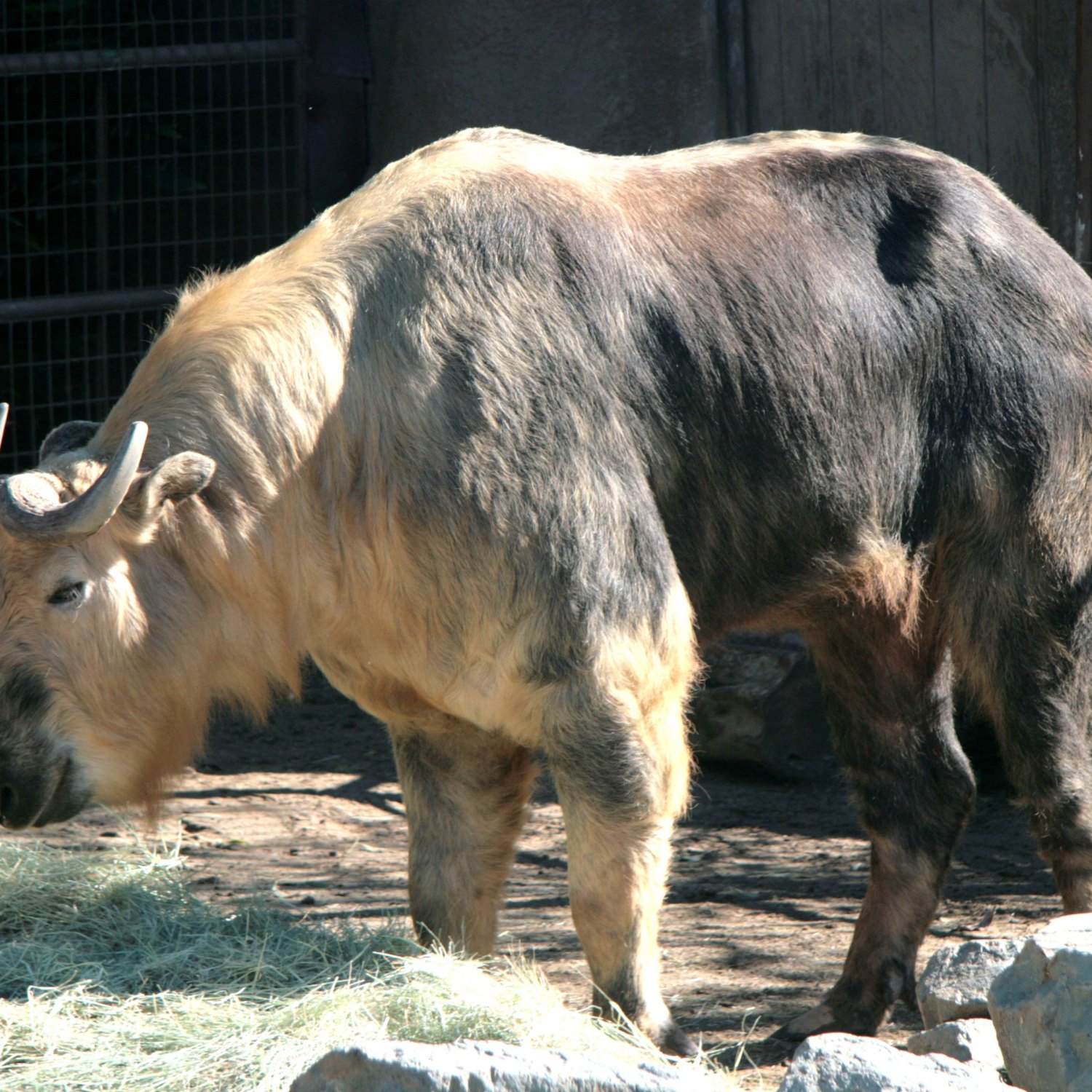
Takin
180-220 cm (71-87 in)
The Takin, a unique animal found in the Eastern Himalayas, is known for its large size and impressive physical abilities. With a length of 180-220 cm and a stocky, muscular body shape, it belongs to the Bovidae family. Popularly called the goat-antelope, this majestic creature is a must-see on your next visit to the Himalayas. #Takin #Himalayas #Bovidae #Wildlife
Animal Details Summary:
Common Name: Takin
Kingdom: Animalia
Habitat: Mountainous regions
The Magnificent Takin of the Eastern Himalayas
The Eastern Himalayas, known for their rugged terrain and breathtaking landscapes, are home to many amazing species. From elusive snow leopards to vibrant pheasants, these mountains are a hotbed of biodiversity. But among these diverse creatures, there is one species that stands out for its unique appearance and behavior - the takin (Budorcas taxicolor).The Takin's Taxonomy
The takin is classified as an animal within the kingdom Animalia, phylum Chordata, and class Mammalia, making it a fellow mammal to humans Takin. It belongs to the order Artiodactyla, also known as even-toed ungulates, and is a member of the Bovidae family, which comprises of antelopes, gazelles, and goats.The scientific name for the takin is Budorcas taxicolor. The genus name Budorcas derives from Tibetan and means "wild cattle," while the species name taxicolor comes from the Greek words "taxis" and "color," meaning "arrangement of colors." This name is fitting for these unique creatures, as they have a distinctive coloration that sets them apart from other mammals.
The Origins of the Takin
The takin originates from the eastern Himalayas, a region of high altitude, rugged terrain, and dense forests. This includes the countries of China, Bhutan, and Myanmar, where these animals roam freely in the mountains.In Bhutan, the takin is considered the national animal and is protected by law. In Chinese folklore, they are seen as symbols of strength, and their meat is believed to have medicinal properties. Unfortunately, due to habitat destruction and illegal hunting, the takin population has been declining, and they are now classified as vulnerable on the IUCN Red List Tarsier.
The Takin's Habitat and Adaptations
The takin's natural habitat is in high-altitude mountainous regions, where they are naturally adapted to survive in harsh environments. They have thick fur and a layer of fat that helps to insulate them from the cold and harsh winds.Their stocky and muscular body shape is also an adaptation for living in rugged terrain, allowing them to navigate steep slopes and rocky landscapes with ease. Additionally, their hooves have a rubbery texture, providing them with better grip on slippery surfaces, such as icy cliffs.
A Herbivorous Diet
Like other members of the Bovidae family, the takin is a herbivore, meaning it primarily feeds on plants and vegetation. They have a specialized digestive system that allows them to survive on a diet of coarse grasses and shrubs, which is necessary in their high-altitude habitat, where food sources are limited.On average, takins consume around 8-10% of their body weight in vegetation each day. While this may sound like a lot, it is a necessary amount for them to maintain their bulky size and high energy needs.
The Takin's Distinct Coloration
The takin's coat is dark brown in the winter months, providing camouflage against the rocky landscapes, but turns golden yellow in the summer, blending in with the dry grasses on the mountain slopes. This color change not only helps them hide from predators but also serves as a signal for mating season. During this time, the dominant males exhibit a brighter shade of golden yellow, making them more attractive to potential mates.Another unique feature of the takin's coat is the thick layer of oily sweat glands, which gives it a greasy appearance. This serves as insulation and protection against the harsh mountain climate.
The Takin's Physical Attributes
Takins are large animals, with a body length ranging from 180 to 220 cm (71 to 87 inches), and they can weigh anywhere from 200 to 400 kg (440 to 880 lbs). This makes them one of the largest goat-like species in the world.They have a distinctive hooked nose, which gives them a characteristic hump on their back. This feature is where they get their nickname, the "gnu goat," as their appearance is a cross between a wild goat and a big wildebeest.
Their horns are another distinguishing feature, sweeping backward and upward from the sides of their head, and can reach a length of up to 30 cm (12 inches). Unlike other bovids, takins do not use their horns for self-defense, but for digging in the soil to find food.
The Takin's Mysterious Behavior
One of the most intriguing aspects of takins is their behavior. They are solitary animals, only coming together during mating season. However, even then, they tend to avoid each other and only interact when it is time to mate.They also have a mysterious habit of disappearing during the summer months and then reappearing in the winter. This behavior has puzzled researchers, as they are believed to live in the same location throughout the year. Some theories suggest that they may migrate to different areas in search of food, while others believe it could be more of a social behavior.
The Takin's Role in Natural Language Processing and Conservation
Natural Language Processing (NLP) is an area of artificial intelligence that focuses on the interaction between computers and human languages. It has numerous applications, including information retrieval, machine translation, and text summarization. In the case of the takin, NLP can play a crucial role in conservation efforts.With the decline in their population, it is vital to gather as much information as possible about takins and their behavior to help protect them in the future. Through analyzing language data from various sources, such as research papers, articles, and social media, researchers can gain insights into the current state of takin populations, potential threats, and conservation efforts.
Additionally, NLP can also be used to educate and raise awareness about the importance of protecting this unique and endangered species. By analyzing public conversations and sentiments, NLP can help identify areas where more education and conservation efforts are needed.
The Takin's Impact on the Ecosystem
As a large herbivore, the takin plays a crucial role in its ecosystem. They help maintain the balance of vegetation by grazing on a variety of plants and keeping certain species from becoming dominant. This not only benefits the plants but also provides food for other animals, including predators.Their grazing habits also help disperse seeds, contributing to the diversity and regeneration of plant life in the mountains. Furthermore, when takins urinate or defecate, they spread nutrients back into the soil, supporting the growth of new vegetation.
The presence of these animals in the ecosystem is vital, and their decline could have a significant impact on the balance of the Eastern Himalayan mountains.
The Future of the Takin
Despite being designated as a vulnerable species, there is still hope for the takin's survival and conservation. In Bhutan and China, efforts are being made to protect their habitat and control illegal hunting. In Bhutan, takins are protected by law, and there are plans to expand the protected areas to help increase their population.Conservation organizations, such as the World Wildlife Fund, are also working towards sustainable management of the takin's habitat and raising awareness about the importance of preserving this unique species.
With continued conservation efforts and the use of technologies such as NLP, it is possible to safeguard the future of the magnificent takin and ensure that they continue to roam freely in the Eastern Himalayas for generations to come.
Conclusion
The takin is a fascinating and unique animal that calls the Eastern Himalayas its home. From its distinct coloration and physical attributes to its mysterious behavior, there is still much to learn about these magnificent creatures. As we continue to discover more about the takin, it is essential to also work towards their protection and conservation. By doing so, we can ensure that the takin remains a symbol of strength and a vital contributor to the biodiversity of the Eastern Himalayas. Whether through natural language processing or conservation efforts, we must all play a role in preserving this incredible species for future generations.

Takin
Animal Details Takin - Scientific Name: Budorcas taxicolor
- Category: Animals T
- Scientific Name: Budorcas taxicolor
- Common Name: Takin
- Kingdom: Animalia
- Phylum: Chordata
- Class: Mammalia
- Order: Artiodactyla
- Family: Bovidae
- Habitat: Mountainous regions
- Feeding Method: Herbivorous
- Geographical Distribution: Eastern Himalayas
- Country of Origin: China, Bhutan, Myanmar
- Location: Eastern Himalayas
- Animal Coloration: Dark brown to golden yellow
- Body Shape: Stocky and muscular
- Length: 180-220 cm (71-87 in)
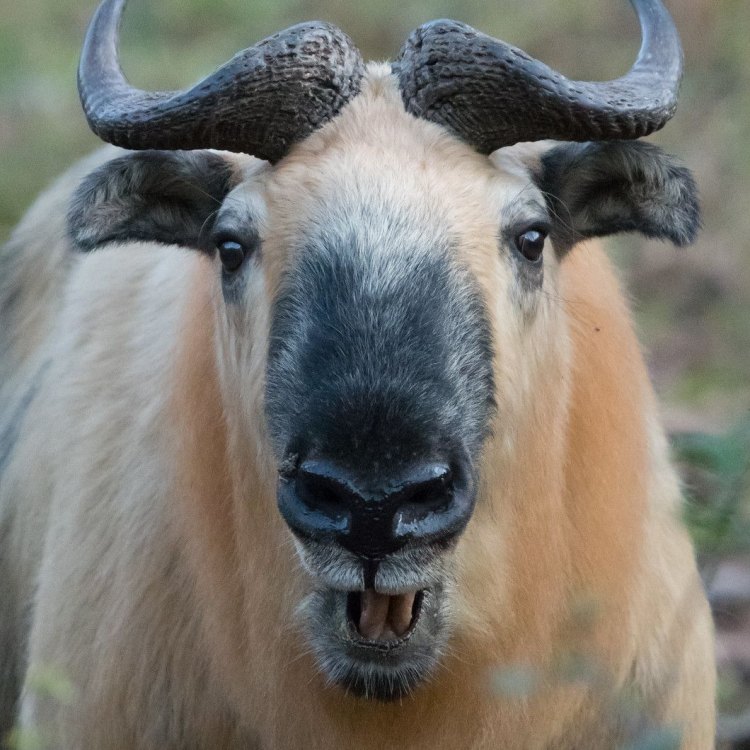
Takin
- Adult Size: Large
- Average Lifespan: 10-15 years
- Reproduction: Sexual
- Reproductive Behavior: Polygamous
- Sound or Call: Roaring
- Migration Pattern: Migratory
- Social Groups: Solitary or small groups
- Behavior: Primarily diurnal
- Threats: Habitat loss, hunting
- Conservation Status: Vulnerable
- Impact on Ecosystem: Important herbivores, help shape the environment
- Human Use: Traditional medicine, meat, trophy hunting
- Distinctive Features: Large size, thick neck, arched back, curved horns
- Interesting Facts: Considered a national animal in Bhutan, known for extraordinary climbing abilities
- Predator: Snow leopard, common leopard, Asiatic black bear
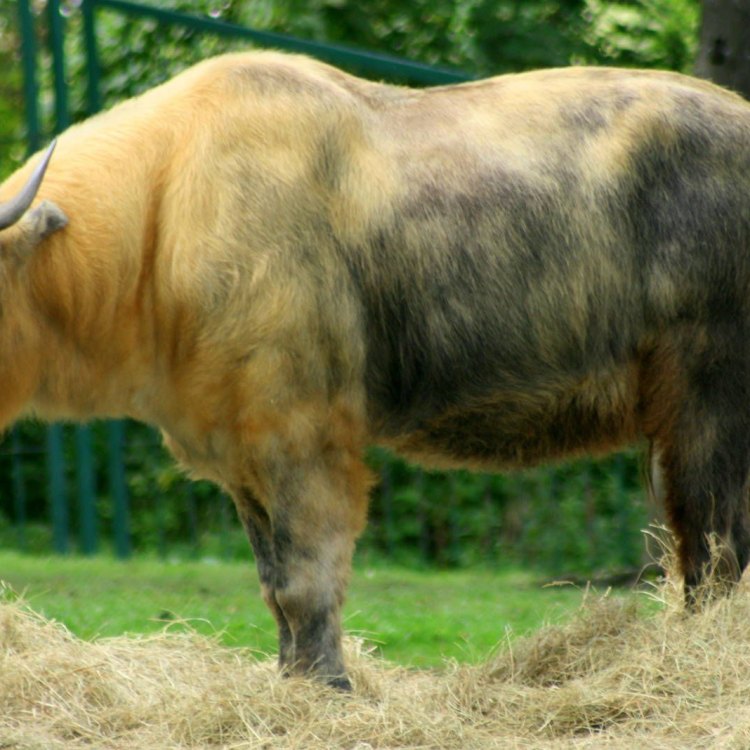
Budorcas taxicolor
The Takin: A Majestic and Unique Creature
Nestled in the high-altitude mountains of the eastern Himalayas, lives a creature that is shrouded in mystery and admired for its majestic presence - the Takin. This impressive animal, also known as the "gnu goat," is a member of the bovidae family and is native to a few select countries in Asia, including Bhutan, China, and India. With its distinctive features, interesting behaviors, and significant role in the ecosystem, the Takin is a fascinating creature that deserves to be explored.Appearance and Size
The Takin is a large animal, easily recognizable by its bulky built and unique features PeaceOfAnimals.Com. It stands at an average shoulder height of around 1.2 meters and can weigh up to 350 kilograms, making it the largest goat antelope in the world. Their thick neck, arched back, and sturdy legs give them a powerful and imposing presence. But the most notable feature of the Takin is its curved horns, which grow up to 30 centimeters in length and give this animal a regal look.
Behavior and Social Structure
The Takin is a solitary animal, often found wandering alone or in small groups of up to 20 individuals. However, during the breeding season, they form larger herds of up to 100 Takins. During this time, the males engage in a competitive behavior where they use their horns to fight for a mate. This behavior is known as a "horning" and is often seen as a display of dominance and strength.
When not engaged in mating rituals, Takins are primarily diurnal, meaning they are most active during the day Tiffany. They are known to be excellent climbers, thus often spotted in steep, rocky terrains. With their strong and agile bodies, they can effortlessly navigate through challenging terrain, including snow-covered mountains.
Reproduction and Lifecycle
Like most mammals, the Takin reproduces sexually, and females give birth to one or two calves after a gestation period of 6-7 months. The breeding season typically occurs between June and October, resulting in the birth of newborns in the following spring months. Young Takins are born with a brown coat and have a reddish tinge to their fur, which they lose as they mature into adulthood. Takins have a relatively long lifespan of 10-15 years in the wild.
Sound and Calls
One of the most distinctive features of the Takin is the sound of its call, which is often described as a loud, bellowing roar. This sound is used to communicate with other Takins, particularly during the breeding season. The roar can also be heard when Takins are stressed or in pain.
Migration Patterns
The Takin is a migratory animal, and its movements are highly dependent on the availability of food and favorable weather conditions. During the summer months, they migrate to higher elevations, where the weather is cooler, and vegetation is abundant. With the arrival of winter, they return to lower elevations in search of food and shelter. These migratory patterns play a vital role in the distribution and survival of the Takin population.
Threats and Conservation
The Takin is listed as vulnerable on the International Union for Conservation of Nature (IUCN) Red List due to habitat loss and hunting. The construction of roads and development of infrastructure in their natural habitat have caused a significant decline in their population. Additionally, the Takin is also hunted for traditional medicine, meat, and trophy hunting, which further endangers their existence.
To protect the Takin population, conservation efforts have been put in place, including the establishment of protected areas and strict hunting regulations. The traditional belief among the Bhutanese people that Takin meat has medicinal properties has also led to increased awareness and efforts to conserve this unique animal.
Importance in Ecosystem
The Takin plays a critical role in the ecosystem as an essential herbivore. They feed on a variety of plants, including grasses, leaves, and bark, thus helping to shape the environment. Their grazing habits prevent the overgrowth of vegetation, which can cause imbalances and harm other species. Furthermore, their nutrient-rich excrement helps to fertilize the soil and promote plant growth.
Human Use
The Takin has been a significant part of the culture and tradition of the countries where it resides, particularly Bhutan. In Bhutan, the Takin is the national animal and holds significant cultural and religious significance. Their meat is also a delicacy in some parts of Asia, and their body parts are used in traditional medicine. Additionally, trophy hunting of this majestic animal is still legal in some areas, which raises concerns about the conservation of the species.
Fascinating Facts
The Takin is a mysterious creature with many interesting facts and legends attached to it. In Bhutanese mythology, it is believed that the Takin was created by the combination of two animals - a goat and a yak. This belief has also led to the Takin's inclusion in the traditional Chinese and Tibetan astrology. Takin's also possess extraordinary climbing abilities, and have been spotted in some of the highest mountain peaks, including Mount Everest, at 7,000 meters above sea level.
Predators
The Takin is vulnerable to several predators, including the snow leopard, common leopard, and Asiatic black bear. These predators are natural hunters, and their presence in the Takin's habitat poses a significant threat to the species.
In conclusion, the Takin is a magnificent creature, adorned for its unique features, extraordinary abilities, and cultural significance. With its status as a vulnerable species, it is crucial to ensure the conservation of the Takin, not just for our admiration, but also for the role it plays in maintaining a healthy ecosystem. This beautiful animal is a true testament to the diversity and wonder of our planet's wildlife.
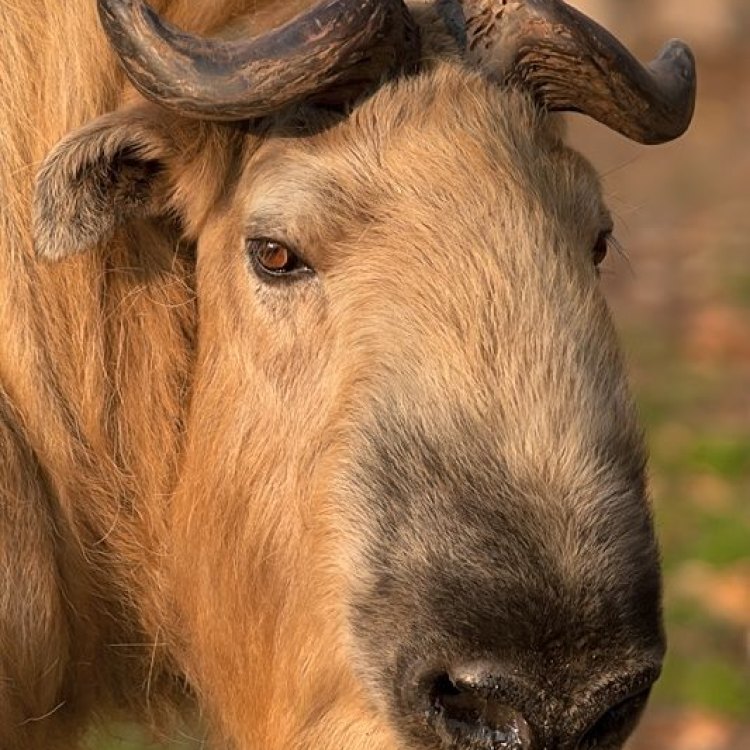
The Magnificent Takin of the Eastern Himalayas
Disclaimer: The content provided is for informational purposes only. We cannot guarantee the accuracy of the information on this page 100%. All information provided here may change without prior notice.

